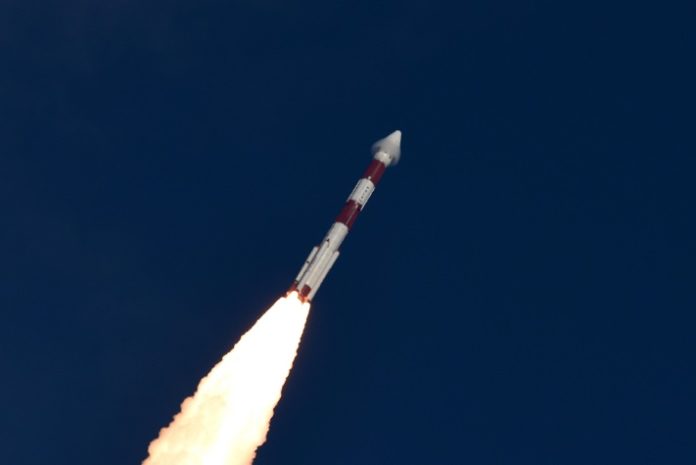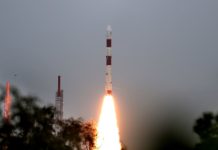India’s Space Research Organisation (ISRO) has ended the year 2019 with a successful launch of the RISAT-2BR1 satellite. During this PSLV-C 48 mission nine foreign satellites were also launched under a commercial arrangement with New Space India Limited (NSIL). Six of these nine satellites belong to the USA and one each to Israel, Italy and Japan: Israel’s remote sensing Duchifat-3 satellite was built by their student community, while Japan’s QPS-SAR is a radar imaging earth observation satellite, and Italy’s Tyvak-0092 is for search and rescue purposes. There are four multi-mission Lemur satellites from Spire, and the other US satellites include a technology demonstration satellite called Tyvak-0129 and an earth imaging satellite called 1HOPSAT.
This was the 50th flight of the rocket PSLV (Polar Satellite Launch Vehicle). This rocket has played a pivotal role in India’s space program over the years. Although this rocket has been chiefly designed for putting less than two tons of payload into Low Earth Orbit (LEO), ISRO has been very innovative with it and has even used this vehicle to successfully launch India’s first moon mission (2008) and Mars Orbiter Mission (MOM 2013).
ISRO has provided some interesting statistics with regards to this launcher, which has been used for all of ISRO’s commercial launches so far.To date, this versatile launcher has lifted off 52.7 tonnes into space, of which 17% belongs to customer satellites.
Chandrayaan-2
The year 2019 had brought many positives for India’s overall space agenda. The second mission to moon undertaken by ISRO, Chandrayaan-2, for example, attracted major global attention. Unfortunately, this mission was ‘so near yet so far’. The mission was partially successful, with ISRO having correctly established the orbiter in the vicinity of moon and the orbiter is expected to provide valuable data inputs for next seven years. However, the lander-rover system was not able to achieve a soft landing as planned. The lander was hardly 2.1 km away from the moon’s surface when the system malfunctioned. Now, ISRO is planning to repeat the mission, possibly around November 2020. Definitely there have been lot of lessons learnt for ISRO, from this partially successful mission.
India’s ASAT test
Another important ‘statement’ mission done by India in March 2019 was the success of an anti-satellite (ASAT) test, which was actually a part of India’s missile program and not its space agency ISRO. The only role played by ISRO was that of making available a ‘target’ for conducting this test.
For the ASAT test, a target satellite called Microsat-R was launched in January 2019. This satellite was successfully injected into the intended orbit of 274 km. The reason behind making this satellite available in such a low orbit was to ensure that most of the debris created during the ASAT test would eventually enter the earth’s atmosphere and get burned off.
ISRO’s radar capabilities
The RISAT-2BR1 satellite launched by ISRO on 11 December 2019 is the fourth radar satellite launched by ISRO so far. Such radar satellites could be categorised as dual-purpose satellites, being essentially remote sensing satellites with major surveillance utility. For many years ISRO’s focus was towards the development of optical sensors for their various remote sensing (earth observation) satellites. However, these sensors have limitations and are less effective during bad weather, and for collecting information with typical terrain and topographic features. India’s geographical boundaries with the neighbouring states have features like seas, deserts, snowclad peaks and thickly vegetated mountain ranges. Obviously, getting correct information from these areas, especially during night-time, was a challenge. Hence, ISRO started developing SAR (synthetic aperture radar) technology.
The impetus to acquire radar satellites began unfortunately, in November 2008, when India experienced one of the most major terror attacks in its history. India’s financial capital Mumbai witnessed 12 coordinated shooting and bombing attacks lasting for four days and killing more than 160 people. Because of security challenges, an immediate need for reconnaissance satellites was felt, and India imported the SAR sensor from Israel. With this the first radar satellite was launched during 2009. The table below provides the details about India’s radar satellite inventory.
| Name of Satellite | Launch date | Location | Weight | Comments |
| RISAT 2 | 20 Apr 2009 | 434 km at inclination of 41 degree | 300 kg | SAR from Israel |
| RISAT 1 | 26 Apr 2012 | 536 km, inclination of 97.5 degrees | 1,858 kg (including 950 kg of SAR payload mass) | Indian SAR |
| RISAT 2B | 22 May 2019 | 556 km at an inclination of 37 degree | 615 kg | Indian SAR |
| RISAT 2BR1 | 11 Dec 2019 | 576 km at an inclination of 37 degree | 628 kg | Indian SAR |
| RISAT 2BR2 | Was planned for Dec 2019 | Proposed | ||
| RISAT 1A | 2020 | Proposed |
All these satellites are very high-resolution satellites and have a design life of five years. There was some controversy with respect to RISAT-1, when there emerged some reports that around September 2016, possibly owing to debris, this satellite had gone dead. However, ISRO never confirmed these reports and declared that the satellite had become dysfunctional. With the recent launch, now India two operational satellites RISAT-2B and RISAT-2BR1. However, a lot of gaps in intelligence gathering still exist owing to the revisit rate, hence there is a need for India to undertake other two proposed launches at the earliest.
Other launches of 2019
Earlier in November 2019, ISRO successfully launched its cartographic satellite called Cartosat-3. Along with this, 13 commercial nanosatellites were also launched. Like RISAT, Cartosat is also an important category of satellites developed by ISRO for strategic utility. These satellites have submeter resolution. Cartosat-3 satellite is a third-generation satellite with a very high-resolution imaging capability (around 30 cm). The first of this series, Cartosat-1, was launched in 2005 and subsequently, seven satellites have been launched in the Cartosat-2 series.
On April 1 2019, ISRO launched a satellite called EMISAT which is meant for electromagnetic spectrum measurements. This satellite also has defence utility and could help detecting and gathering electronic intelligence from enemy radars across the borders, as it circles the globe roughly from pole to pole every 90 minutes. Apart from this satellites, 28 nanosatellites were also launched for various customers. Approximately a year back during Nov 2018, Hyperspectral Imaging Satellite for Earth observation was launched by ISRO which is known to have a defence utility. This launch had also carried 30 satellites for various customers.
All in all, ISRO’s satellite launches during last one-year period demonstrates ISRO’s potential towards strengthening India’s strategic capabilities. In addition, they have also undertaken many small satellites launches for various global customers. All this essentially indicates the maturing of ISRO into an agency which can successfully conduct conventional space missions, deep space missions, strategic missions and commercial missions.







